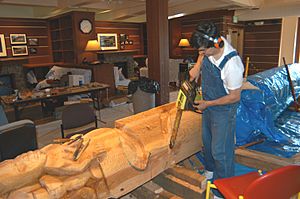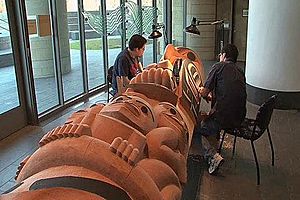David A. Boxley facts for kids
David A. Boxley, born in 1952, is a famous American artist. He is from the Tsimshian tribe in Alaska. He is best known for making many beautiful Totem Poles and other traditional Tsimshian art.
Boxley grew up in Metlakatla, Alaska. This town is home to many Tsimshian people. His artworks are made in the old Tsimshian style. They are known all over the world. He is one of the most active modern makers of Totem Poles. He has carved over 70 poles. These poles are in famous places like Disney World in Florida. One is also in the Smithsonian National Museum of the American Indian. It is always on display there. His other carvings are in museums. Royal families and nobles in Europe and Asia also own his art.
David Boxley has also helped bring back Tsimshian culture. He started Tsimshian dance groups. He helped restart the traditional ceremony called Potlatch. He also shares knowledge of the Tsimshian language.
Boxley lives in Lynnwood, Washington. His sons, especially David R. Boxley, are also successful artists and carvers. He is part of the Laxsgiik (Eagle clan). He has four Tsimshian names. One means "First to Potlatch" and another means "He Who Works with the Cedar." In 2023, he published a book about his life and work. A writer named Steve Quinn helped him with the book.
Contents
David Boxley's Early Life
David Boxley was born in Ketchikan, Alaska, in 1952. He grew up in Metlakatla, Alaska. His grandparents mostly raised him. He spent a lot of time with them as a child. For almost 100 years, Tsimshian culture was suppressed in Alaska. Because of this, traditional Tsimshian culture was almost gone in Metlakatla. This was true for the whole region when Boxley was young.
Unlike most children around him, Boxley was surrounded by Tsimshian culture. This was because his grandparents spoke the Tsimshian language. They also knew many old traditions. He first learned to carve from his grandfather. Boxley often calls his grandfather his "hero." He said his grandfather "could build anything." His grandfather taught him many things. He learned what wood to use for carving. He also learned how to make his own tools. His first artworks were those he helped carve with his grandfather. He still uses a special tool called an adze today. His grandfather helped him make it. Boxley says he wanted to be an artist "since third grade."
After high school, Boxley went to Seattle Pacific University. He earned a Bachelor of Science degree in 1974. Then, he worked for ten years as a high school teacher. He also coached basketball in Seattle, Metlakatla, and Washington. During this time, he started to seriously study Tsimshian art and culture. He looked at the works of older Tsimshian artists. He also studied artists from other Pacific Northwest Coast tribes. These included the Haida and Tlingit people. He also studied art left by the ancestors of these tribes. Boxley used libraries, art classes, and museums to learn. He also took some classes from a well-known Tsimshian artist, Jack Hudson. But Boxley mostly taught himself through his own research. He learned many old art styles and methods that had been forgotten. This research soon took over his teaching. Boxley decided to become a full-time artist and carver in the mid-1980s.
David Boxley's Art Career
Early Artworks (1980s-1990s)
Since the mid-1980s, Boxley has worked on many art projects. One of his first big projects was for the 'Talking Stick' for the 1990 Goodwill Games. Boxley designed the top part of the stick. He made it a symbol of peace. It showed the American eagle and the Russian bear together. This symbolized peace between the United States and the Soviet Union. The stick even had messages from the leaders of both countries. President George H.W. Bush and President Mikhail Gorbachev's words were carved into it. This was an important artwork seen by people worldwide. The stick was carried across states, like the Olympic Torch. Since then, Boxley's fame as a top carver has grown. His art is known internationally.
Famous Totem Poles (1980s-Today)
Boxley is most famous for his Totem Poles. They are displayed across the U.S., Canada, and Europe. They are in many important places.
Totem Poles at Walt Disney World
Three of Boxley's poles are at the Canada Pavilion in Epcot Center. This is in Walt Disney World, Florida. In 1998, he was asked to create a new totem pole for the center. There were already two fiberglass poles there. Disney wanted to make the park more real. So, they asked Boxley to create a new, authentic pole. Then, in 2017, Disney asked Boxley to make two more poles. These new poles replaced the old fiberglass ones. People have praised these poles for being authentic. However, some critics say that putting the poles in a tourist park might make them lose their cultural meaning.
Totem Pole at the National Museum of the American Indian
Another of Boxley's poles is in the Smithsonian National Museum of the American Indian. It is in Washington D.C. This pole is always on display. This is special because the Museum usually changes its exhibits. Only very popular or important artworks stay on permanent display. This was Boxley's 70th pole. It was made from a 500-year-old cedar tree. His son David helped him carve it. Many Native American artists want their art in this museum. Boxley is very proud to have a pole there. He was especially happy that the Tsimshian tribe and his village of Metlakatla were shown to a national and global audience because of the pole. He is only the second modern Totem Pole carver to have a pole in this Museum. The first was Nathan Jackson.
Totem Poles in Metlakatla and the U.S.
Boxley has also carved most of the poles in his hometown of Metlakatla. In 1982, he made the town's first raised pole. Since then, he has made others with carver Wayne Hewson. Together, they have made 11 of Metlakatla's 13 totem poles. Most of his poles are across the U.S. and Canada. Many of these poles have special meaning to him. For example, one stands outside Northwest Hospital in Seattle. It is dedicated to his sister-in-law, who passed away. Another pole is one of three in Metlakatla that stand next to each other. Boxley made the largest one, which is 30 feet tall. He made it to honor his grandfather.
Other Artworks (1980s-Today)
Besides Totem Poles, Boxley has made many other items. These include bentwood boxes, masks, rattles, prints, panels, and paintings. Many of these artworks are in galleries, museums, and art auctions. They are found across the United States and Europe. He has a strong connection with Quintana Galleries in Portland, Oregon. His work is always on display there. Many of his items are also owned by world leaders. These include leaders in Germany, the King of Sweden, and the Emperor of Japan.
Sharing Knowledge (2000s-Today)
Boxley continues to carve today. In recent years, he has focused on teaching younger Tsimshian people. He shares his knowledge and techniques with them. His sons, David and Zachery, have followed in their father's footsteps. They are both successful carvers. David R. Boxley, in particular, is known as a talented carver. He has started making Totem Poles himself. Boxley now works with his sons, stepson, and nephew on most of his projects. Boxley also mentored S'Klallam artist Jeffrey Veregge for a time in 2001. In 2019, Boxley officially took on an apprentice, Dylan Sanidad. He teaches Dylan traditional Tsimshian carving through a special program.
David Boxley's Art Style
Boxley's artworks are made in a very traditional way. He focuses on a unique Tsimshian art style. Boxley first used ideas from different Pacific North West Coast styles. These included Haida and Tlingit styles. But in the mid-1980s, his style became more clearly Tsimshian. He calls his style "Alaskan Tsimshian." This means it is specific to the Tsimshian people in Alaska. For his Totem Poles, he uses old red cedar trees. These are the trees his Tsimshian ancestors used. However, he has changed some traditional materials for modern ones. For example, he uses latex paint instead of old Tsimshian pigments. These old pigments were made from things like copper oxide and charcoal mixed with salmon eggs and urine. Even with these changes, Boxley stresses how important it is to keep everything as traditional and authentic as possible.
Reviving Tsimshian Culture
Since the 1980s, Boxley has also helped bring back Tsimshian culture. Tsimshian communities have praised his work in this area. Because of his efforts, his Tsimshian tribe gave him the title of "culture bearer." He has said this title is the greatest honor he has received. Others outside the Tsimshian community have also praised his work. Quintana Galleries in Portland said of Boxley: "Not all of the artists [in the museum] were reviving a culture, but he was." Kevin Gover, the director of the National Museum of the American Indian, also said: "David Boxley has been key in bringing back the cultural traditions of carving, song, and dance in his Tsimshian community."
One of Boxley's efforts to revive culture was restarting the "Potlatch." This is a traditional ceremony practiced by Native groups in the Pacific North West Coast of the U.S. and Canada. In 1982, Boxley led the first Potlatch in Metlakatla in over a century. He also made songs and dances for the event. He also raised a Totem Pole he made. Since then, he has led other Potlatches across the Pacific Northwest.
Another of Boxley's contributions is starting and leading traditional Tsimshian dance groups. The most famous one is the "Git-Hoan." This means "People of the Salmon." Boxley's son David now leads this group. The group has performed across the United States, Canada, and Europe. They have been very successful and received much praise. The Git-Hoan group combines traditional Tsimshian song, language, and dance. They also use masks, costumes, and instruments made by Boxley. Boxley also makes sure the Git-Hoan performances are authentic. He has researched song styles, dances, costumes, and ornaments. He used old materials like a 1913 silent film and a wax audio reel. All these authentic traditions are shown to people around the world. The Git-Hoan dancers performed many times at the Disney Epcot Center. This was part of the ceremony for the two poles he raised there in 2017. These performances have been praised for bringing real Native American culture to the park. It has been one of the few true Native American performances at the park since it opened.
Boxley also cares about keeping the Tsimshian language alive. Only about 70 people in Alaska still speak it. He and his son David are involved in Tsimshian language classes. Also, both Boxleys write songs for their Git-Hoan dance group using the traditional Tsimshian language. They do this on purpose to let more people hear the language.
Thanks to his efforts, Metlakatla has seen a strong return of traditional culture. Younger generations of the Tsimshian tribe now have the chance to be surrounded by their traditional culture.



